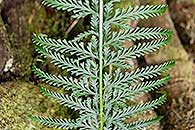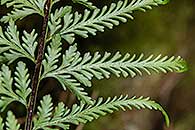Asplenium sertularioides Baker
Synonyms |
|
|---|---|
Common name |
|
Description |
Growth form unknown. Rhizome scales (assumed from scales on lower stipe) narrowly triangular, to 8 x 1 mm, apex gradually tapering to a point, or (assumed from young Grimshaw frond) pale brown, ovate, to 8 x 2 mm, pointed. Fronds tufted, subcoriaceous. Stipe up to at least 27 cm, with dark brown scales to 8 mm. Lamina oblong-lanceolate in outline, 20-56 x 5-10 cm, 2- to 3-pinnatifid with acroscopic basal lobe often enlarged and almost free, lower pinnae reduced and only shallowly lobed. Pinnae in 24-35 pairs, lanceolate in outline, 3.7-7.5 x 1 cm, pinnatifid, sessile, base unequal, costa shortly winged, glabrous above, sparsely set with scales below. Rhachis with sparse scales. Sori 1 per lobe, 1-2 mm long; involucre 0.5-0.7 mm wide. |
Notes | |
Derivation | |
Habitat | Upper heath zone, mossy rock crevice in moorland. |
Distribution worldwide | See African distribution. |
Distribution in Africa |
|
Growth form |
. |
Literature |
|



